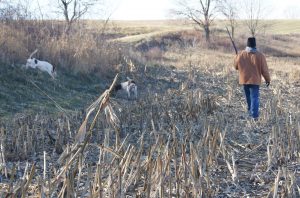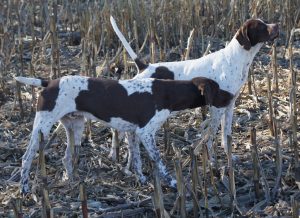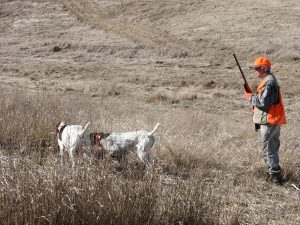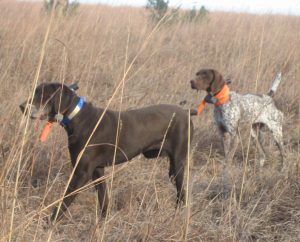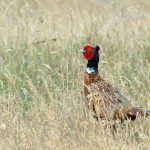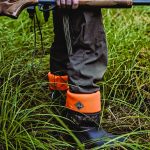POINTING DOG POINTERS: Hunting Dogs Together
By Bob and Jody Iler
It’s your young pointing dog’s first season – and you’re both raring to go! A good buddy of yours has a young pointing dog too. You’re wondering if the two of you should hunt your dogs together.
Or maybe you’d like to head to the Dakotas to hunt your started dog. There will be other hunters at the camp who will be hunting their dogs. Should you go, and if you do, should you and your dog join them?
A friend of yours has a mature, fairly well-trained pointing dog. Should you hunt your young dog with this older, experienced dog? Maybe the older dog could teach your dog a thing or two!
When considering different hunting scenarios like these, first evaluate your own dog’s level of training and experience. Then look at the level of training and experience, plus the age and sex, of any dog, or dogs, that you and your dog might hunt with. Some pros and cons listed below may help you with your decisions.
Pros of Hunting Dogs Together
- Manners in pups is not as strict an issue as in mature dogs. Young dogs are going to make mistakes, and that’s OK! If the two pups that are hunted together get along well, this can be a good social activity for them as they learn to hunt with a companion.
- Some pups have a wider range than others. If your pup is a “boot polisher” and hunts a little closer than you would like, hunting him with a dog that has a wider range in the field may help to draw your dog out and cause him to run “bigger.” Conversely, sometimes hunting a bigger-running dog with a closer-working one can cover all the bird bases and result in some nice bird work!
- If you’re hunting a large area, two dogs will cover more ground and hit more birdy objective areas that might be missed with only one dog hunting. Game preserves often have fields of varying sizes to address this issue and give you a choice, depending on whether you hunt your dog alone or with another.
Cons of Hunting Dogs Together
- Your young, started dog needs to develop his bond with you in the field before hunting him with your buddy and his dog. If time isn’t taken to do this, young dogs can become confused by different commands, too much whistleblowing, and signals – all given by two different hunters. You may find your pup taking off with your buddy and his dog – and ignoring your commands.
- Some young dogs like to “tailgate.” This happens when one pup follows the other as the first pup hunts, trying to get the pup to play or otherwise harassing him and keeping the first pup from hunting. This can become a bad habit and correction is in order. Separating the dogs and hunting in different directions can help.
- If one pup is pointing a bird staunchly, the other young dog could run in and steal his point or bump the bird. With pups, mistakes like this are not such a big deal, but too much of this can create future problems.
- Hunting a well-trained, older dog with good manners with a younger dog that has less training can create problems. Puppies want to get in on all the action and can be distracting to the older dog. All the hard work and time put in developing the well-trained dog can come unraveled in this scenario.
- Contrary to often popular thought, older dogs may sometimes “teach” younger dogs bad lessons, rather than “teaching them how to hunt.”
- Although game preserves are great places to further develop your pup, beware of hunting too close to another group in a nearby area – particularly if that group is shooting excessively. Too many shots nearby, when your dog isn’t working a bird, could create problems with the gun for your young dog.
- Never rule out the possibility of a dogfight when hunting dogs together, and plan accordingly to prevent this. Two mature dogs of the same sex may be very competitive and may not hunt well together if they are not acquainted beforehand.
Pros of Hunting in the Dakotas
- Hunting your dog on wild birds in the Dakotas, or other areas where wild birds are plentiful, can provide the finishing touch on your training program and will develop your dog’s abilities as no other experience can.
Cons of Hunting in the Dakotas
- Hunting a young, inexperienced dog in the Dakotas early in his first season can be a train wreck. Too many birds can “blow a pup’s mine” and cause him to lose all semblance of training. Too many other hunters and dogs will add to the mix of confusion and even possible chaos. Too much snow cover can quickly dampen a young dog’s enthusiasm. Wait until your pup has some experience below his belt before you make that trip.
Hunting two dogs together can be lots of fun! More dogs added to the mix, though, may multiply the possible problems, so keep things simple, especially in the beginning. Take time to evaluate each dog’s temperament and level of training (as well as their owners!) before putting two dogs together to hunt. Agree on who will do the shooting for each bird and on how you will each handle your dog. Some thought and planning ahead of time provide the ounce of prevention so important in developing your pup to his best potential!
Pointing Dog Pointers features monthly training tips by Bob and Jody Iler, who own Green Valley Kennels in Dubuque, Iowa. Bob and Jody have trained pointing dogs for over 35 years and have written many articles for Pointing Dog Journal.



